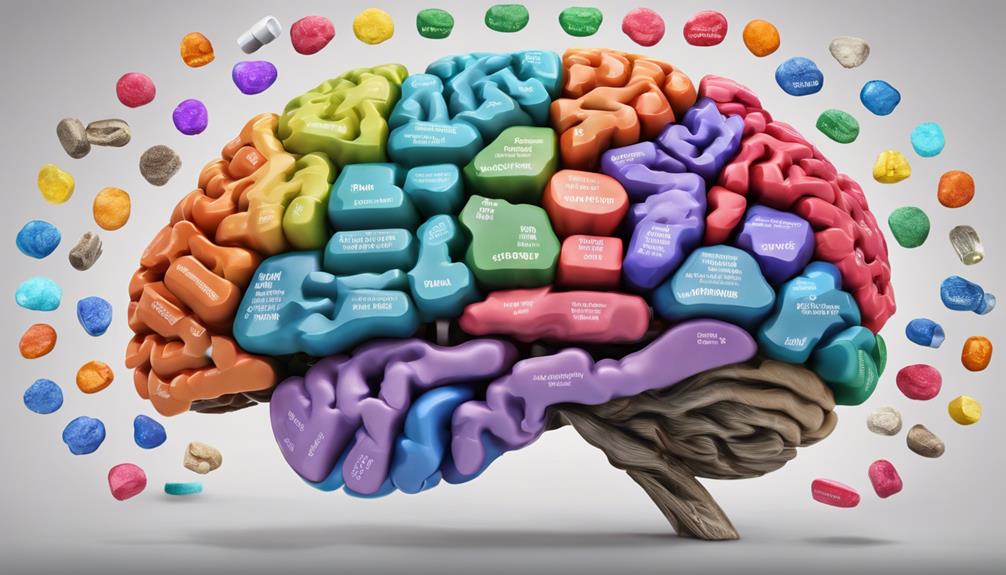To support your recovery, focus on engaging in memory and cognitive exercises like puzzles, memory games, and attention drills. Practice tasks that challenge your focus, such as tracking objects or completing sequence puzzles, to rebuild your neural pathways. Incorporate activities into your daily routine gradually increasing difficulty to boost your progress. Staying consistent and motivated is key—if you keep at it, you’ll find more effective strategies to enhance your mental recovery over time.
Key Takeaways
- Incorporate targeted brain training activities like puzzles and memory games to stimulate neural pathways.
- Use attention drills such as tracking objects or focusing on sounds to improve concentration.
- Practice daily with varied exercises, gradually increasing difficulty to enhance cognitive skills.
- Work with therapists to develop personalized routines that support memory and attention recovery.
- Consistent practice fosters confidence, independence, and overall improvement in daily functioning post-stroke.

Recovering from a stroke often involves rebuilding memory and cognitive skills, but engaging in targeted exercises can make a crucial difference. One effective approach is brain training, which focuses on specific activities designed to stimulate your brain and improve mental functions. These exercises are tailored to strengthen neural pathways, helping you regain focus, problem-solving abilities, and memory. Attention drills are a core component of brain training that can enhance your ability to concentrate amidst distractions. They often involve tasks like tracking objects, completing puzzles, or focusing on specific sounds or images, all aimed at sharpening your attention span. By regularly practicing these drills, you’ll notice improvements in your ability to stay engaged and process information more efficiently.
Attention drills boost focus, rebuild cognitive skills, and enhance daily functioning after a stroke.
You might find that attention drills are especially helpful early in your recovery. These exercises train your brain to filter out irrelevant stimuli and concentrate on what matters most. For instance, you could practice focusing on a single conversation in a noisy environment or completing tasks that require sustained attention over time. Over time, these drills help rebuild your capacity to concentrate, which is essential for daily activities like cooking, driving, or working. Brain training exercises often incorporate simple yet effective tools such as flashcards, digital apps, or pen-and-paper tasks, making them accessible and easy to integrate into your routine. Incorporating a variety of exercises can further enhance overall cognitive recovery by engaging different neural pathways.
Consistency is key when engaging in memory and cognitive exercises. Set aside a dedicated time each day to practice attention drills and other brain training activities. As you progress, increase the difficulty to challenge your brain further—adding more complex puzzles, timed tasks, or multitasking activities. This gradual escalation encourages continuous growth and prevents plateaus. Remember, it’s normal to experience frustration or fatigue, but persistence pays off. Celebrate small victories along the way, like recalling a sequence more quickly or maintaining focus longer than before.
Incorporating these exercises into your recovery plan can also foster a sense of control and motivation. You’re actively participating in your rehabilitation, which can boost confidence and overall well-being. If possible, work with a therapist or cognitive specialist who can customize your brain training routines and attention drills, ensuring they align with your specific needs and progress. Ultimately, consistent effort and targeted exercises can immensely enhance your cognitive abilities, helping you regain independence and improve your quality of life after a stroke.
Frequently Asked Questions
How Soon After a Stroke Should Cognitive Exercises Begin?
You should start cognitive exercises as soon as your healthcare team advises, often within days after a stroke. Timing considerations emphasize early intervention to promote better recovery. Engaging in these exercises early helps stimulate brain function and prevents further decline. Always follow your doctor’s guidance, but don’t delay—beginning exercises promptly can make a significant difference in regaining cognitive skills and improving overall outcomes.
Are There Specific Exercises Tailored for Different Stroke Types?
Yes, there are stroke-specific therapies tailored for different stroke types. You should engage in lesion-focused exercises designed to target your particular brain injury. These specialized exercises help improve your cognitive functions based on your stroke’s location and severity. Working with a therapist ensures your therapy is customized to your needs, promoting better recovery. Remember, personalized stroke-specific therapy optimizes your chances of regaining cognitive abilities effectively.
Can Memory Exercises Improve Overall Daily Functioning Quickly?
Yes, memory exercises can quickly boost your overall daily functioning by improving memory retention and enhancing cognitive flexibility. When you actively practice recalling information and adapting to new tasks, you strengthen neural pathways, leading to better problem-solving and multitasking. Consistent exercises help you become more efficient in everyday activities, making it easier to remember appointments, follow instructions, and adapt to changes, ultimately supporting your independence and confidence.
What Role Does Diet Play Alongside Cognitive Exercises?
Diet plays a crucial role alongside cognitive exercises by providing essential nutritional support that boosts brain health. You should focus on a balanced diet rich in fruits, vegetables, and omega-3 fatty acids while managing any dietary restrictions your doctor recommends. Proper nutrition enhances brain function, improves energy levels, and helps your cognitive exercises become more effective. Combining these strategies can accelerate your recovery and support overall well-being after a stroke.
How Do I Measure Progress in Memory Recovery?
Picture your progress like a growing tree, each new leaf representing a step forward. To measure your memory recovery, use regular memory assessments that evaluate recall, recognition, and problem-solving skills. Keep a journal or progress tracker to visualize improvements over time. This approach makes progress tracking clear, helping you stay motivated and identify areas needing extra focus, much like watching your tree grow taller and fuller with each passing day.
Conclusion
So, if you think these exercises are just silly tricks, think again. They’re your secret weapon against forgetfulness and confusion—because who doesn’t want to remember where they left their keys or their own name? Keep at it, laugh at the setbacks, and celebrate the tiny wins. After all, a little effort now means you might just outsmart that stubborn brain of yours someday. Remember, even a slow brain can catch up—eventually.









